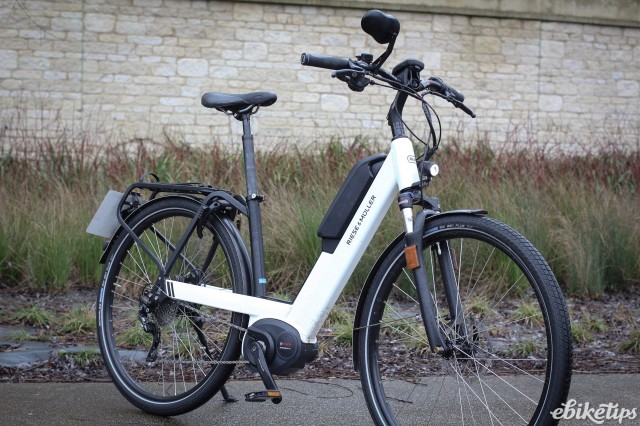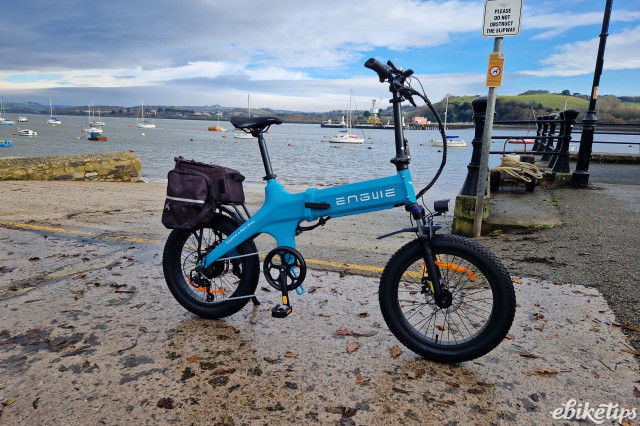You know how motorists are always banging on about how cyclists “don’t pay road tax”? Well check out what I’ve been riding. My bike has a number plate and everything. Welcome to the confusing world of speed pedelecs in the UK.
I was contacted by Dan Jones, the UK sales manager for Riese und Muller bikes, asking me if I wanted to try a speed pedelec. If you’re not aware of the different types of e-bike in the EU, then there are basically two standards.
The first is the bikes that make up the huge majority of the market: standard pedelecs. These bikes conform to the EU’s EN15194 regulations, and the basic stipulations of these are:
- The bike must be pedal assist, not throttle-based
- The bike must have a continually rated power output of 250W or less
- The speed limit for assistance must be 25km/h
Although the UK has its own law, these regulations are the ones that are enforced. The only major divergence between UK and EU law is that in the UK there’s a minimum age limit of 14 years, and older (pre-2016) ‘twist and go’ bikes with a full-speed throttle are considered to be legal even though they wouldn’t be if they were new. Confused yet?
Faster, faster!
Above that standard there’s another: the speed pedelec, or S-pedelec. These bikes have a maximum assisted speed of 45km/h, and more powerful motors. They’re widely available from a range of manufacturers; Riese und Muller offer nearly all their bikes in a HS (High Speed ) build. And this is where it gets really complicated.
The adoption of the S-pedelec in Europe is on a state-by-state basis: there are no overarching EU regulations specifically for these bikes. Anything faster or more powerful than the EN15194 regulations allow technically needs to be type approved as a motor vehicle. There are two standards: L1e-A, for motors up to 1Kw and speeds up to 25km/h, and L1e-B, for motors up to 4Kw and speeds up to 45km/h. I did tell you it was complicated.
Anyway, S-pedelecs, because they’re faster, fall into the second category. They’re legally classed as mopeds, so you have to have a driving licence, the vehicle needs to registered, taxed and insured, and you need to wear the correct safety equipment: a motorbike helmet. That’s a huge amount of hoops to jump through to get what’s effectively just a faster bike, so many EU countries have introduced their own legislation to cover S-pedelecs and circumvent those rules, at least a bit. Generally this means they need to be licensed, but you don’t necessarily need to be insured or have a driving license. The actual stipulations vary from country to country.
Jumping through the hoops
In the UK there’s no S-pedelec legislation. So if you’re riding one, you’re legally riding a moped, and all the laws regarding mopeds apply. Hence the number plate. To get your number plate, you have to go through a pretty long and arduous process:
- First, find yourself a bike. You’ll need to make sure it comes with a Certificate of Conformity, and that it conforms to 168/2013/EU regulations; you’ll need the certificate later.
- Head off to the DVLA and get yourself some forms. You’ll need a V267 (New vehicle import pack) and a V55/4 (Application for a licence for a new motor vehicle and declaration for registration). They take about a week to arrive.
- Complete the V267 & V55/4 with the information from the Certificate of Conformity.
- Send everything with a cheque for £55 and the original Certificate of Conformity off to the DVLA. You’ll need to include a bank statement and/or utility bill, and a copy of your driving license or passport.
- Wait for your V5C registration document to come back: this takes about two weeks
- Check your vehicle tax - it’s exempt, so there’s nothing to pay
- Get a standard vehicle number plate (around £10 online) and fix it to the rear of your bike
- Arrange some insurance - Bikesure quoted £135 third party only & Quoterack quoted £200 fully comprehensive for this bike
- Find yourself a kite-marked motorcycle helmet. An open-face moped helmet will cost from about £30 upwards.
And you’re done! So you’re looking at a process that’s likely to take about a month, and cost you at least £200, on top of what you’ve spent on your bike.
Lucky for me, Dan from R&M went through all this so I didn’t have to. Mostly he found that people didn’t really understand the bike, or what he was doing. “Insurance was probably the worst”, he said. “It’s extremely difficult to obtain, most insurance companies just don't recognise the vehicle so are unable to offer insurance, and despite having cycled for more that 30 years on the road this counts as nothing towards no claims because it is a motorcycle.”
The driving licence is another sticking point. If you passed your test before 2001 then you have “grandfather rights” that allow you to ride a moped without any further training, but if you passed after that you’ll need to complete a motorcycle CBT course, and that’ll cost you another £100.
Then there’s the MOT: by law you’ll have to get your S-pedelec checked every year once it’s three years old. But the MOT regulations are written for petrol mopeds, not e-bikes, so garages may not understand what to do, and bike shops won’t be able to MOT the bike even though they’re the people that will know whether it’s working properly. “I strongly feel that the the best people to assess the road safety of this vehicle is a cycle shop”, says Dan, “so it would be better if it had a service book that needed to be stamped every year rather than an MOT which will be carried out in a location that doesn't understand the bike or its operation."
Remember: it’s not a bike
Riding this £3,599 Riese und Muller Nevo HS Touring is just like riding any other e-bike, really. It’s a bit quicker, and that makes longer journeys a bit more manageable. I’ve been on 20-mile round trips which are significantly quicker than they would be on a standard 25km/h pedelec. So that’s good. An S-pedelec opens up longer commutes that would normally be done by car, and the fact that it’s quicker means it’s more capable of keeping up with traffic on UK roads that have very little provision for cyclists. For a 12-mile commute from Bristol to Bath, as an example, it's easily quicker at rush hour than getting in the car, especially when you consider parking at each end.
It’s not all positives though. For a start, there are plenty of places you can’t legally ride this bike. Anything that’s shared use is out of bounds, so the traffic-free paths round here such as the Bristol-Bath and the Two Tunnels are off the menu. But more than that there are countless little cut-throughs and paths even on road routes that I’d tend to use to keep out of the traffic, and those are all out as well. Round here motorbikes are allowed in bus lanes, so that’s okay. But if you live somewhere where they’re not, you can’t use the bus lanes either. If you’re on the road when there is a cycle lane provided (that you can’t legally use), you’ll be getting it in the neck from drivers too, no doubt. You're legally bound to the speed limits too, so if I roll down the hill to work faster than the 20mph limit and get picked up for it, that's three points on my licence.
Things should change
Here at ebiketips we think that things need to change. An S-pedelec doesn’t ride like a moped, it rides like a bike. It’s a bit quicker, but realistically hardly any more so than a fit cyclist would be. If we’re going to reduce car dependency in the UK, and offer people better transport choices, then bikes like the Nevo I’ve been riding would certainly be appealing to people with commutes that are too long or hilly for a regular bike, or even a standard e-bike. But the amount of red tape and cost surrounding them makes them hard to recommend in the UK right now. It’s no surprise that people are chipping their standard e-bikes to be faster – or just buying an S-pedelec and riding it as a bike – when the law stands as it does.












